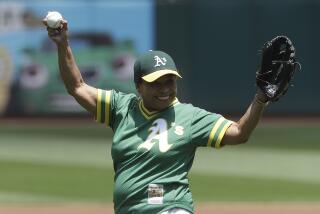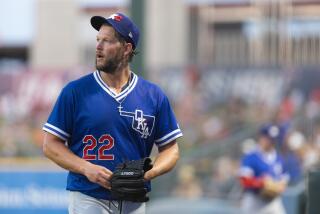It’s all about green, again, for A’s
- Share via
This wasn’t about the money.
You hear someone in sports say those words, and skepticism is the natural reaction. But Billy Beane zigs when baseball zags, with enough success to suppress the skepticism.
Eric Chavez is the survivor within the Oakland Athletics’ clubhouse. He watched Jason Giambi go, and Miguel Tejada, and Tim Hudson and Mark Mulder and Barry Zito.
“It always seems like we’re reinventing ourselves yearly in Oakland,” Chavez said. “This is obviously to the extreme.”
This wasn’t about the money, not this time.
So says Beane, the general manager. He traded Dan Haren, the American League starting pitcher in the All-Star game, and starting outfielders Nick Swisher and Mark Kotsay, all for prospects.
Chavez isn’t thrilled, but he isn’t skeptical. He is 30, a six-time Gold Glove winner at third base, expected to start the season on the disabled list in the aftermath of off-season back surgery. He might not last long enough to represent the A’s in October again, but he’s a believer.
“At my age, rebuilding is what it is. It’s rebuilding,” he said. “In Billy’s case, and in the case of the organization, it’s absolutely the right thing to do.”
The A’s opened the season against the Boston Red Sox in Japan today, the defending World Series champions against Daric, Kurt and two guys named Jack. The A’s don’t believe they’ll lose 100 games or finish last in the American League West, but Beane won’t worry if they do.
“Short-term discomfort has never bothered me,” he said. “The thought of long-term discomfort bothers me.
“If you wait too long and hit bottom, you usually hit it with a thud.”
The A’s finished in third place last year at 76-86, their first losing record in nine years. The voluntary introduction of short-term discomfort followed, one year after the A’s advanced to the American League Championship Series.
“To be honest with you, after we went to the ALCS in 2006, I thought about redoing it,” Beane said. “We had a good 10-year run. For us to get back to sustained success, we had to do it.”
If you’re waiting for Beane to say the A’s weren’t good enough to win, keep waiting. But a rash of injuries last season exposed a lack of depth, and Beane decided to rebuild rather than take his chances on a full recovery from almost the entire first string.
“We had the talent,” he said. “We needed the health. We weren’t exactly optimistic on the health prognosis.”
The A’s used the disabled list 22 times last season, with as many as 11 players on the list at one time.
They were above .500 as late as Aug. 23 but lost 22 of their last 33 games, with Chavez, Kotsay, shortstop Bobby Crosby, outfielder Travis Buck and pitchers Justin Duchscherer and Rich Harden sitting out all of those games because of injury.
“Last year bit everybody,” Chavez said. “When your margin for error is so slim as it is anyway, you can’t gamble on my health, on Rich Harden’s health, on Justin Duchscherer’s health, on Chad Gaudin’s health. . . .
“It was way too much.”
So out went Haren, signed for another two years at an eminently affordable $9.5 million, traded to Arizona for six youngsters, including four of the Diamondbacks’ top eight prospects.
And out went Swisher, signed for another four years at a relatively modest $25 million, traded to the Chicago White Sox for three of their top six prospects.
And out went Kotsay, signed for one year at $8 million, traded to the Atlanta Braves for two pitching prospects. The A’s even paid most of Kotsay’s salary, essentially buying better arms in return.
If you’re scoring at home, that’s 11 prospects to Oakland, instantly turning a thin farm system into a deep one. And Beane might not be done: Joe Blanton could go, or closer Huston Street, or Harden, he of the wondrous yet fragile arm, if he can pitch even 10 games for the first time in three years.
“Just because you’ve moved some doesn’t mean you move all,” Beane said. “You move them when you get the deals you like.
“It’s not a fire sale. We don’t have payroll issues.”
He did cite payroll issues in 2004, when he traded star pitchers Hudson and Mulder for six young players, including Haren. The A’s shrugged and won 88 games in 2005, breaking in Haren, Blanton, Street, Swisher and first baseman Dan Johnson in the process.
“We all played well,” Blanton said. “Just because you’re a rookie doesn’t mean you can’t play well.”
The A’s shuffle their roster well, and often, even if they sometimes draft poorly. They have more players on their 40-man roster acquired in trades than in the draft, a rarity in an era when low-revenue teams insist they must build through the draft.
Oakland has not lost 100 games in three decades. But veteran designated hitter Mike Sweeney, who played on four 100-loss teams with the Kansas City Royals, knows a 100-loss team when he sees one and said these A’s are not one.
“No way,” Sweeney said.
Sweeney gushed over outfielder Carlos Gonzalez, the key prospect acquired in the Haren trade.
“I haven’t seen young talent like that since Carlos Beltran,” Sweeney said.
“A lot of the so-called geniuses in the game have written off the Oakland A’s in ’08. There’s a lot of very talented guys here. I think the Oakland A’s are going to surprise a lot of people this year.”
The owner is counting on it. Lew Wolff, who yields to Beane on personnel matters and describes the trades as “fairly brilliant,” won’t even concede the A’s will suffer any short-term discomfort.
“I think we’ll do better this year than last year,” Wolff said. “I don’t think it’s a complete rebuilding. I think it’s a spot rebuilding.
“People tend to focus on one player sometimes. I think we’re a better team in total.”
--
More to Read
Go beyond the scoreboard
Get the latest on L.A.'s teams in the daily Sports Report newsletter.
You may occasionally receive promotional content from the Los Angeles Times.











